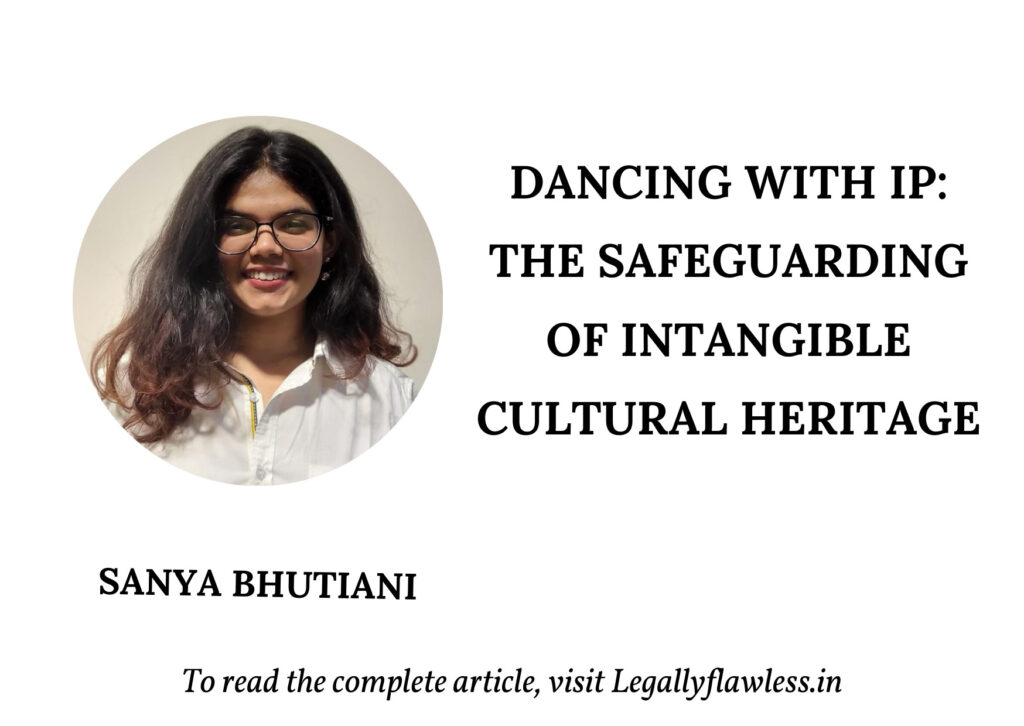
Table of Contents
Introduction
The recent inclusion of Garba in the United Nations Educational, Scientific and Cultural Organization (UNESCO) Register of Intangible Cultural Heritage (ICH) has generated considerable interest in the media. Gujarat’s popular dance and worship form of Garba is the very embodiment of the feminine spirit. The night-long festival in which Ma Durga is venerated is celebrated with great favour and devotion.
Intangible cultural heritage (ICH) components deemed valuable and in need of preservation are included in the ICH List, created by the UNESCO Convention of 2003. Communities embrace Intellectual Property Rights as a way to protect their ICH. This can give communities a way to safeguard and manage how their cultural heritage is used. IPRs have the potential to collectively proprietarize culture, which supports multilevel governance and inclusive social protection systems
Intangible Cultural Heritage: A critical examination
Intangible Cultural heritage may be defined as “an invaluable resource and an irreplaceable repository of knowledge “which promotes social cohesion, employment, and economic growth” [1]. This archive includes both physical and incorporeal intangible elements. The UNESCO Convention for the Safeguarding of Intangible Cultural Heritage also known as ICH identifies ICH as those practices, representations, expressions, knowledge and skills–as well as the instruments, objects, artefacts and cultural spaces associated with and which the communities, groups, in some cases, individuals recognize as part of their cultural heritage.
Intangible cultural heritage, as defined by this convention, can include any of the following:
- Performing arts;
- Oral traditions and expressions, which include language as a vehicle of the intangible cultural heritage;
- Social practices, rituals, and festive events;
- Knowledge and practices concerning nature and the universe; and
- Traditional craftsmanship.
To ensure the improved conservation of significant intangible cultural heritages around the globe, UNESCO developed its list of Intangible Cultural Heritage which has 700 significants to its list.Though as of 10th December, 2023 India has got only 15 properties on the UNESCO list; our national list is much wider.
The purpose of the listing mechanism under the UNESCO 2003 convention is to increase intangible cultural heritage’s prominence by raising consciousness about its importance and encouraging culturally diverse discourse. However, the mere fact of being listed does not translate into automatic safeguarding and preservation. Issues like the prevention of commercialization are still prevalent.
Examining the specific case of IPR related to Garba and Navratri
An interesting case to consider here is D.R. Dwivedi versus The State of Gujarat and others.
(Special Civil Application No. 9979 of 2009). [2] The petitioner in this case had filed a public interest litigation apprehending disruption of the Garba festival by law implementation establishments, after the defendants, ie. The Indian Performing Rights Society Ltd (henceforth known as IPRS) had lodged a complaint. The respondents stated that the proceedings of the said festivals were not in line with the Copyright Act, 1957.
The society which has been founded under section 33 (3) of the copyright act. The primary goal of the society’s founding is to keep an eye on, defend, and uphold the privileges, rights, and interests of its writers, composers, and music publisher members. These members have given IPRS ownership and management power over the copyrights to any literary and musical works they have produced. According to IPRS’s claim, using any of the aforementioned works in IPRS’s repertoire without first obtaining a license from IPRS is considered a copyright infringement under Section 51 and Section 14(a) (iii) of the Copyright Act,1957. IPRS claims that music performances throughout the festival without taking appropriate permissions constitute infringement. Reportedly, IPRS had written notifications to several establishments, including hotels, nightclubs and dining establishments, highlighting the requirement to get a license from them at the tariff rates that apply to the public performance of music.
The position taken by the petitioner was that there could not be any requirement to obtain such a license for conducting performances of Garba or Dandiya; festivals that are an integral part of Gujarati culture and belong to the public domain because they were long before the Copyright Act was enacted. He also contended that IPRS’s actions could lead to serious law and order issues as the festivals were celebrated with great enthusiasm in the state. However, IPRS expressed that the petitioner had not produced any proof indicating that the companies who put on these festivals and shows are either amateur clubs or religious organizations. Again, even though “bona fide religious ceremonies” are exempt from copyright infringements under Section 52(za) of the Copyright Act, IPRS attempted to show that the events in question included music and an admission fee; as a result, it was impossible to believe that they fell within the definition of what the legislature had intended to be “bona fide religious ceremonies”.
In addition, the society also cited previous incidents in which several Garba/Dandiya event organizers had performed such music in public and had also previously received licenses from IPRS for the same.IPRS had also contested the petitioner’s locus standi, claiming that neither the general public interest nor any of the petitioner’s constitutional or fundamental rights had been negatively impacted by its measures to protect the interests of its members. The judges expressed the opinion that the petitioner in this instance was motivated only by a desire for notoriety rather than a sincere concern for the welfare of the public. In addition, the Court acknowledged the validity of IPRS’s concern to protect its members’ interests by stopping the previously mentioned copyright infringement. The Court moreover acknowledged that any unauthorized public performance of the musical pieces included in IPRS’s repertoire would be considered a violation of those rights.
Notwithstanding the above case, but also because of the harm and danger brought forth by international industrialization and urbanisation, there has been an urgent need to conserve and protect our rich and varied intangible cultural heritage-also known as ICH. Protective steps should be taken to protect and maintain the rich ICH. Intangible cultural heritage (ICH) can be viewed not just as co-created community wisdom, traditions etc. but also as intellectual creation.
Intangible cultural heritage and intellectual property rights (IPRs) are thus two concepts that are closely related
Deciphering Predatory Pricing in India: A Legal Analysis Through Judicial Precedents
Navigating the murky relationship between ICH and IPR
The relationship between IPR and ICH has been quite complex, to say the least. The UNESCO 2003 Convention’s Ethical Principles (2015)[3] effectively express the fundamental principle that tradition bearers and practitioners should identify their ICH and its significance to them, as well as take the initiative to ensure its maintenance and conservation, as well as its relevance to them. In the Operational Directives of UNESCO (2020) [4], IP rights are cited as a useful tool to ensure the sustainable expansion of ICH, helping to minimise over-commercialization and misappropriation. The Directives, refer to IP rights as a useful tool for ensuring ICH’s sustainability and assisting in preventing over-commercialisation and misappropriation.
In fact, countries like the US and Australia and a few other nations support protecting ICH within the current IPR framework. Bodle et al. [5] investigated the question of ICH preservation from an economic standpoint and suggested treating ICH as assets that fall under the purview of intellectual property protection for indigenous cultures. Madhavan [6] looked at the growing property rights approach to safeguarding Tibetan medicine, which is a type of ICH. To safeguard international ICH, Ubertazzi [7] suggested creating a new framework. In the opinion of Aimin Qi [8], intellectual property rights (IPRs) encompass a vast array of topics, and safeguarding them requires a holistic strategy that integrates the IPR system as a whole with active innovation inside the IPR framework.
Intellectual property tools can be useful when innovations that take cultural heritage into account result in performances or products that meet intellectual property protection standards, such as new choreography based on traditional dance steps or a new design and colour patter which are developed and based on earlier skills.
Previous scholarly investigations [9–13] have also recognised the function of IPR in protecting ICH and have delineated means by which communities may protect and profit from their ICH using a combination of diverse IP rights protection approaches, agreements, and ethical principles.
However, communities—which are described as groups of people with a “shared history, shared experience, shared practice, shared knowledge, shared values” play a much more important role when dealing with ICH than they do with individuals, and our “individualistic” IP systems find it extremely difficult to accept this circumstance, For example, there have been proposals for the protection of traditional cultural expressions through law, owing to abuse of traditional cultural works. Though most disciplines, including yoga, have insufficient protection under international law, intellectual property plays a role in preserving traditional knowledge.
Application of traditional intellectual property (IP) rights like copyright, patents, and design protection is restricted to cultural services and goods based on ICH since ICH is passed down through generations and develops and evolves as we adjust to new conditions. Whether widely utilised IP-based technologies may be used to prevent the negative effects of over-commercialization is a topic of increasing disagreement.
It may be challenging to use the existing IP tools from a practical perspective. For example, copyright and performer rights are often appropriated for modern works in which the identity of each individual author and performer is identifiable-, which is not the case for ICH. ICH by its very definition has been handed over from generation to generation. The sheer variety of ICH also makes it difficult to bring it under an umbrella of unified legislation.
A very considerable challenge for the usage of IP laws also lies in their implementation and enforcement. For instance, enforcing copyright and performers’ rights agreements is quite stimulating due to myriad reasons including the cost of enforcement. Similarly, geographical indications might face the intricacies of the local relevant court system.
Conclusion and the Way Forward
In this context, countries like India have been moving to the creation of a Sui Generis Regime. Sui generis is defined as something “of its kind” that is special, unique, and different. This could be achieved by adjusting some aspects of the current intellectual property regime to account for the distinctive qualities of ICH. It would also be necessary to comprehend the policy’s requirements, beneficiaries, and concepts of equitable sharing and prior informed consent. In addition to providing space for access and benefit-sharing to safeguard the varied body of ICH that India possesses. Under the tutelage of the Ministry of Industry and Commerce, India developed and espoused the National Intellectual Property Rights policy in 2016, demonstrating its commitment and determination in its path to promote IP. It’s noteworthy to observe that traditional knowledge, art, and culture are listed in the policy’s vision statement as important knowledge resources for advancing national development and enhancing its competitive advantage. Incidentally, it is significant to state that over several years, the World Intellectual Property Organisation (WIPO) has tried to provide sui generis intellectual property protection on a global scale, but this has not been effective so far.
This article is authored by Ms. Sanya Bhutiani, student at Institute of Law Nirma University.
1. Vecco, M.; Srakar, A. The unbearable sustainability of cultural heritage: An attempt to create an index of cultural heritage sustainability in conflict and war regions. J. Cult. Herit. 2018, 33, 293–302. 1https://www.sciencedirect.com/science/article/abs/pii/S1296207418301444?via%3Dihub
2 https://www.casemine.com/judgement/in/56b48efa607dba348fff69b5
3. https://ich.unesco.org/en/ethics-and-ich-00866
4.https://ich.unesco.org/en/directives
5.Bodle, K.; Brimble, M.; Weaven, S.; Frazer, L.; Blue, L. Critical success factors in managing sustainable indigenous businesses in Australia. Pac. Account. Rev. 2018, 30, 35–51. https://www.emerald.com/insight/content/doi/10.1108/PAR-02-2016-0017/full/htm
6. Madhavan, H. Below the radar innovations and emerging property right approaches in Tibetan medicine.J. World Intellect. Prop. 2017, 20, 239–257.
https://onlinelibrary.wiley.com/doi/10.1111/jwip.12084
7. Ubertazzi, B. EU Geographical Indications and Intangible Cultural Heritage. IIC-Int. Rev. Intellect. Prop.Compet. Law 2017, 48, 562–587. https://link.springer.com/article/10.1007/s40319-017-0603-0
8 Qi, A. Integrated IPR Protection for Intangible Cultural Heritage. Electron. Intellect. Prop. 2007, 2007, 15.
9. Farah, Paolo Davide and Tremolada, Riccardo, Global Governance and Intangible Cultural Heritage in the Information Society: At the Crossroads of IPRs and Innovation (September 1, 2015). in Daniele ARCHIBUGI and Andrea FILIPPETTI, HANDBOOK OF GLOBAL SCIENCE, TECHNOLOGY, AND INNOVATION, Handbooks of Global Policy Series, Oxford: Wiley Publisher (United Kingdom), ISBN: 978-1-118-73906-8, DOI: 10.1002/9781118739044.ch22, September 2015, pp. 462 – 479, Available at SSRN: https://ssrn.com/abstract=4042956
10. Deacon Harriet, and Smeets Rieks. 2018. “Intangible Heritage Safeguarding and Intellectual Property Protection in the Context of Implementing the UNESCO ICH Convention.” In Safeguarding Intangible Heritage: Practices and Politics, edited by N. Akagawa and L. Smith, 36–53. London: Routledge.
11. Janke, T. (2003). Minding culture: Case studies on intellectual property and traditional cultural expressions. WIPO
12. Lixinski, L. (2019). International Heritage Law for Communities: Exclusion and ReImagination. Oxford University Press. Lixinski, L. (2020). Commercialising Traditional Culture: Promises and Pitfalls in the Convergence of Intellectual Property Law and Cultural Heritage Law. Annali italiani del diritto d’autore, della cultura e dello spettacolo (AIDA), forthcoming
13. Bhattacharya, Ananya, Madhura Dutta, and Charlotte Waelde. “Designing Heritage-Sensitive IP and Marketing Strategies for ICH-Based Creative Economy.” Culture. Society. Economy. Politics 1.2 (2021): 72-87
14. https://intapi.sciendo.com/pdf/10.2478/csep-2021-0012
15. The Relationship between Intangible Cultural Heritage, Sustainable…. https://link.springer.com/chapter/10.1007/978-3-031-08104-0_6.
16. Introduction | Springer Link. https://link.springer.com/chapter/10.1007/978-3-031-08104-0_1.
17. Intellectual Property Rights and Intangible Cultural Heritage – Springer. https://link.springer.com/chapter/10.1007/978-3-031-08104-0_4.
All efforts are made to ensure the accuracy and correctness of the information published at Legally Flawless. However, Legally Flawless shall not be responsible for any errors caused due to oversight or otherwise. The users are advised to check the information themselves.





